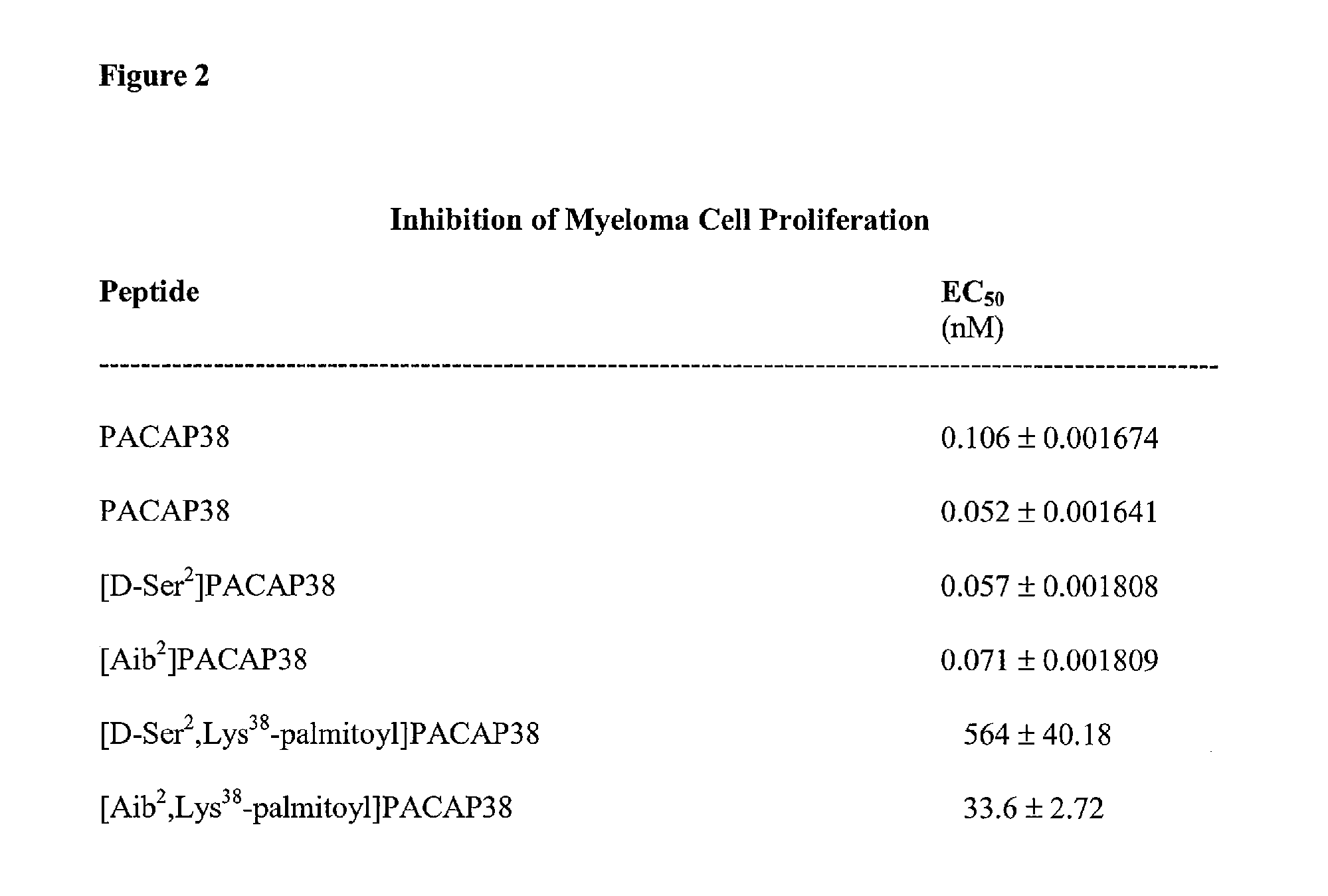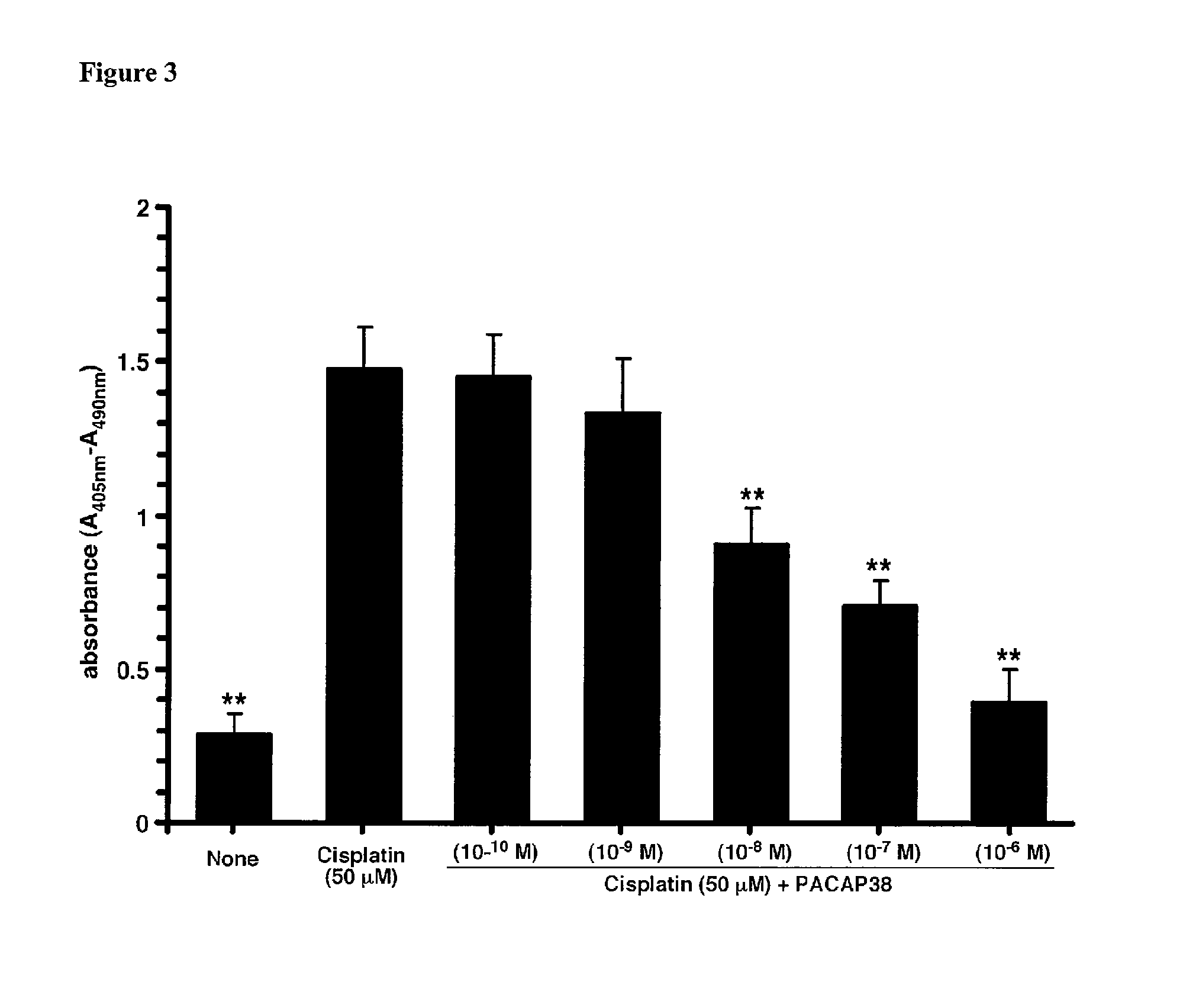Use of pituitary adenylate cyclase-activating polypeptide (PACAP) and pacap analogs as adjunctive treatments with anticancer agents
a technology of adenylate cyclase activating polypeptide and adenylate cyclase, which is applied in the direction of anti-noxious agents, peptide/protein ingredients, anti-body medical ingredients, etc., can solve problems such as injuries to one or more and achieve the effect of protecting the major organs of the body
- Summary
- Abstract
- Description
- Claims
- Application Information
AI Technical Summary
Benefits of technology
Problems solved by technology
Method used
Image
Examples
example 1
Reduction of Cisplatin-Induced Cytotoxicity by PACAP and PACAP Analogs
[0221]Cisplatin (cis-diamminedichloridoplatinum(II), Platinol) is the first-in-class platinum-based DNA-crosslinking anticancer therapeutic. It was approved for clinical use by the U.S. FDA in 1978. The other members of this class of alkylating-like platinum-based anticancer agents now include (but are not limited to) carboplatin, oxaliplatin and satraplatin. Cisplatin is one of the most widely used cancer chemotherapeutics and is the cornerstone of many multi-drug anticancer regimens. Nephrotoxicity is usually the dose-limiting toxicity for the use of cisplatin in cancer chemotherapy, but sensory neuropathies can sometimes limit the doses that can be used to treat some patients.
[0222]Treatment of human renal proximal tubule epithelial cells with cisplatin resulted in a large significant increase in apoptotic cell death (FIG. 3). The addition of PACAP38 to the medium resulted in a significant dose-dependent reduct...
example 2
Reduction of Doxorubicin-Induced Renal Toxicity by PACAP and PACAP Analogs
[0225]Daunorubicin, which is made by the actinobacterium Streptomyces peucetius, was the first anthracycline anticancer therapeutic to be discovered. Doxorubicin (14-hydroxydaunorubicin, Adriamycin) was developed shortly afterwards. The other anthracycline anticancer agents used clinically now include (but are not limited to) epirubicin, idarubicin and valrubicin. Doxorubicin is a potent inhibitor of both DNA and RNA synthesis and is one of the most widely used cancer chemotherapeutics. It is commonly used to treat leukemias, lymphomas, multiple myeloma, and cancers of the breast, bladder, uterus, ovaries, and lung. Cardiotoxicity is usually the dose-limiting toxicity for the use of doxorubicin in cancer chemotherapy, but nephrotoxicity can sometimes limit the doses that can be used to treat some patients.
[0226]Treatment of human renal proximal tubule epithelial cells with doxorubicin resulted in a large signi...
example 3
Reduction of Bleomycin-Induced Pulmonary Toxicity by PACAP and PACAP Analogs
[0227]Bleomycin, which is a family of glycopeptides made by the actinobacterium Streptomyces verticillus, was discovered in 1962. Bleomycin (Blenoxane) was approved for clinical use by the U.S. FDA in 1973. It causes DNA strand breaks and is used to treat Hodgkin's lymphoma, squamous cell carcinomas and testicular cancer. Pulmonary toxicity is usually the dose-limiting toxicity for the use of bleomycin in cancer chemotherapy
[0228]Treatment of human pulmonary epithelial cells with bleomycin resulted in a large significant increase in apoptotic cell death (FIG. 12). The addition of PACAP38, [D-Ser2]PACAP38 or [Lys34]PACAP38 to the medium resulted in a significant dose-dependent reduction in bleomycin-induced apoptotic cell death of the human pulmonary epithelial cells. At the highest dose tested (10−6 M), all three peptides reduced the apoptotic cell death of these epithelial cells by more than 60%. These expe...
PUM
| Property | Measurement | Unit |
|---|---|---|
| Mass | aaaaa | aaaaa |
| Mass | aaaaa | aaaaa |
| Molar density | aaaaa | aaaaa |
Abstract
Description
Claims
Application Information
 Login to View More
Login to View More - R&D
- Intellectual Property
- Life Sciences
- Materials
- Tech Scout
- Unparalleled Data Quality
- Higher Quality Content
- 60% Fewer Hallucinations
Browse by: Latest US Patents, China's latest patents, Technical Efficacy Thesaurus, Application Domain, Technology Topic, Popular Technical Reports.
© 2025 PatSnap. All rights reserved.Legal|Privacy policy|Modern Slavery Act Transparency Statement|Sitemap|About US| Contact US: help@patsnap.com



